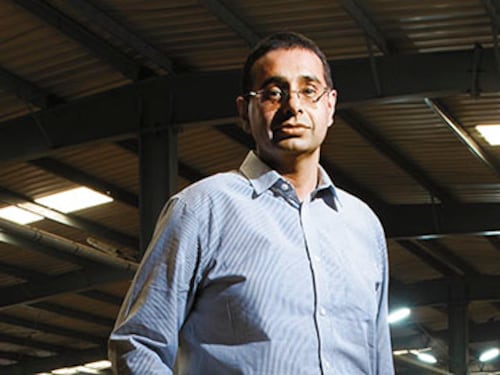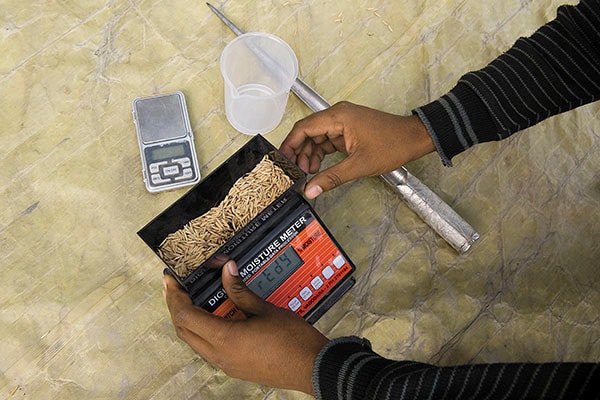How Sohan Lal is solving the problem of agri-commodity wastage
By almost eliminating wastage, Sohan Lal Commodity Management has cracked the code of agri-commodity storage. Its model can help India modernise its post-harvest management practices


An hour north of Delhi along National Highway 1, a warehouse leased by Sohan Lal Commodity Management is filled to capacity with sacks of grains and pulses. The bags, neatly marked and assayed, are stacked high in the 5,000 square feet storage facility at Sonepat. Here, quality checks are conducted frequently, the grains are aired and, most importantly, steps are taken to ensure that no moisture seeps into the bags.
Through the course of routine quality checks, bags are punctured and samples taken. Reports made on handheld tablets are immediately sent to Sohan Lal’s head office in Delhi. The manager tells us that random audit checks keep the staff on their toes and the possibility of grains missing or getting spoilt is nil.
It is this certainty of quality, and efficiency of management that has catapulted Sohan Lal to the top league of commodity management in India. Even without owning warehouses (the company leases its storage facilities), it is excelling at agri-logistics. The Sonepat warehouse, for instance, is miles ahead in terms of management compared to similar facilities run by the state-owned Central Warehousing Corporation or the Food Corporation of India, where reports of grains being eaten by rats or rotting in the open are common.
Over the last three years, the ministry of agriculture reported an average grain production of 242 million tonnes in India. But more than 10 percent of this was lost due to bad storage practices. “If agriculture in India has to improve, this 10 percent wastage has to be reduced dramatically,” says Nikhil Khattau, managing director at private equity (PE) firm Mayfield Advisors Pvt Ltd, which invested an undisclosed amount in Sohan Lal in 2011.
The government traced the problem of post-harvest grain loss to inadequate storage facilities. In 2013, the Union Budget tried to address the issue by launching the Gramin Bhandaran Yojana, where the central government pledged to provide 25 percent of the cost of building or renovating rural godowns.
That, according to Sandeep Sabharwal, 44, chief executive of Sohan Lal Commodity Management, was a wrong approach. Since 2004, he’d been pursuing a different track and was convinced that the problem had more to do with improper management than inadequate storage facilities. And, so far, his bet has resulted in the creation of a Rs 1,800-crore company that has the potential to grow manifold.
In 1995, when Sabharwal—a freshly-minted MBA graduate from the Fore School of Management, Delhi—joined Sohan Lal, it was just a dal mill in the capital city owned by his family. He soon realised that the business created little value addition and could not grow beyond a point—he had to find new avenues to expand.
Sabharwal was aware that inefficient storage practices had long been the bane of Indian agriculture. Farmers couldn’t get government agencies to procure their entire produce, the agencies had problems managing it and stock keeping was archaic buyers wouldn’t trust the quality of the produce and in the absence of an assured and adequate supply, they were loath to plan business activities. At the same time, private warehouses were easily available for lease across most parts of the country.
If Sohan Lal could set in place systems and practices to preserve the quality of harvested agri-commodities, it would have a huge market to tap. In 2004, Sabharwal made a small start by leasing a warehouse in Lawrence Road, Delhi, and started issuing bar-coded receipts to farmers.
“From day one, I knew we had to make sure our company’s receipts were as good as legal tender. If our receipt said a particular grain of a particular variety was in a particular warehouse, it had to be there. That was the basis on which our business would be built,” says Sabharwal. This system has proved to be so trustworthy that a bar-coded receipt from Sohan Lal is now accepted by banks as surety when farmers approach them for finance. Companies like the US-based agri-giant Cargill and French conglomerate Louis Dreyfus have also contracted Sohan Lal for storing agri-commodities.
Unlike other agri-logistics companies, Sohan Lal does not procure goods from farmers. All it does is provide storage space and, in exchange for a fee, it assures clients that the produce will not be stolen or damaged. As a result, the working capital in this business model is low and also asset light. The business is not very capital intensive.
The company has, however, required capital to expand rapidly across India. For this, it has conducted seven rounds of financing from various investors and Sabharwal has diluted his stake to 24.95 percent in the process. The rapid dilution, in the last five years, has raised eyebrows in the industry but as Sandeep Singhal, managing director of Nexus Venture Partners, explains, “He [Sabharwal] would rather have a smaller share of a larger pie.” Nexus Venture Partners was the first PE company to invest in Sohan Lal when it injected Rs 10 crore for an undisclosed stake in 2010.
The funding has helped Sohan Lal to lease 1,061 warehouses and 20 cold storages with a total capacity of over 2.57 million tonnes spread over 14.28 million square feet in 16 states. The firm has also achieved expertise in handling 366 commodities.
As the scope of Sohan Lal’s operations grew, Sabharwal was always alert to the possibility of fraud. He knew that if the goods, the receipts for which were issued, were not available at the warehouse, his credibility would be at stake. One mishap would create a serious dent in the confidence of clients.
With this in mind, Sabharwal went about standardising procedures. “Warehouses, depending on the quantity of produce they hold, are audited every 30-60 days,” says Karan Sachdeva, head of internal audit at Sohan Lal. He heads a team of a dozen auditors who make surprise visits at warehouses. Through hand-held devices, they take photos, assay the quality of the produce and ensure grains are given enough light, air and fumigation for preservation. Samples are also regularly sent to a laboratory in Delhi for testing. Random quality checks at warehouses ensure that no moisture seeps into the bags containing grains
Random quality checks at warehouses ensure that no moisture seeps into the bags containing grains
It was on account of these stringent quality checks and the consequent low wastage that large banks began to accept Sohan Lal’s receipts to sanction loans. They knew their collateral was safe with the company. (Granting loans to farmers also helped banks to meet their lending targets to the priority sector.)
Now that farmers could hold on to their produce in exchange for a small storage fee, as they awaited higher prices, they had to raise money from banks or non-banking financial companies (NBFC) to tide over their short-term spending needs. Quick to spot the opportunity, Sohan Lal acquired the Chennai-based NBFC BP Jain in March 2014 and renamed it Kissandhan. Today, the agri-financing arm of Sohan Lal has an outstanding loan book of Rs 493 crore.
The fortunes of farmers, too, have moved in step with the company’s. In the past, farmers would be forced to sell their produce even when prices were low. They would have to accept whatever price they got.
Businesses have also benefitted. Earlier, they couldn’t plan their activities as they had to wait till the end of the harvest season to acquire the produce. “It [Sohan Lal’s business model] has allowed some companies to run a just-in-time business,” says Mayfield’s Khattau.
The storage facilities Sohan Lal leases are networked and can be monitored in real time, enabling the company to manage them remotely. This, Sabharwal claims, has enabled him to reduce grain wastage in the warehouses he manages to just 1 percent.
Sabharwal’s next big bet is the Myanmar market where the company recently received a licence to store grains. He also plans to provide a link between rice producers there and importers in India. The African market is also under his lens.
In the next decade, Sohan Lal plans to go both wider and deeper into India. He sees this as a Rs 10,000-crore opportunity that is waiting to be tapped. He’s also clear that the company will never become a procurer or trader of agri-products. Keeping it asset-light and scaling up rapidly is his mantra.
Back at the Sonepat warehouse, sacks of wheat that arrived over three months ago are still preserved. Farmers are waiting for prices to peak in March. The grains, once sold, will be sent to flour mills within a 15-kilometre radius to be crushed and made into aata (flour).
Agri-companies are happy as they don’t have to procure all their produce in January and store it. And farmers get a better price while being assured their grains won’t rot. It’s a win-win for everyone.
First Published: Apr 12, 2016, 07:31
Subscribe Now